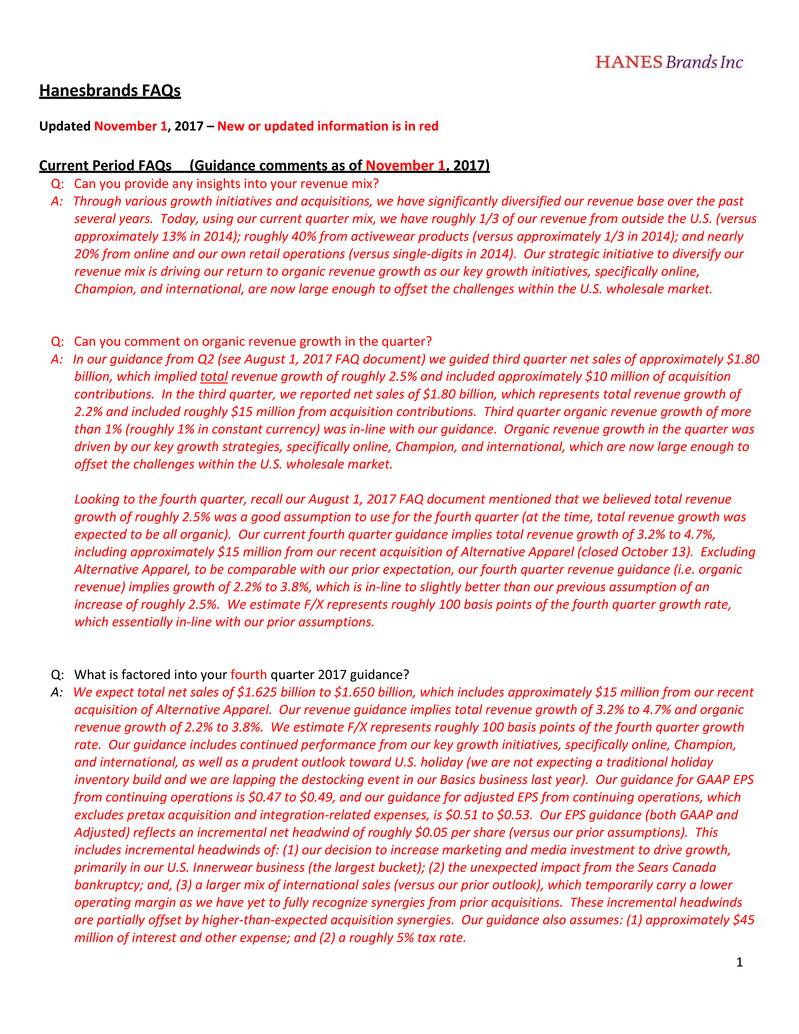
1 Hanesbrands FAQs Updated November 1, 2017 – New or updated information is in red Current Period FAQs (Guidance comments as of November 1, 2017) Q: Can you provide any insights into your revenue mix? A: Through various growth initiatives and acquisitions, we have significantly diversified our revenue base over the past several years. Today, using our current quarter mix, we have roughly 1/3 of our revenue from outside the U.S. (versus approximately 13% in 2014); roughly 40% from activewear products (versus approximately 1/3 in 2014); and nearly 20% from online and our own retail operations (versus single‐digits in 2014). Our strategic initiative to diversify our revenue mix is driving our return to organic revenue growth as our key growth initiatives, specifically online, Champion, and international, are now large enough to offset the challenges within the U.S. wholesale market. Q: Can you comment on organic revenue growth in the quarter? A: In our guidance from Q2 (see August 1, 2017 FAQ document) we guided third quarter net sales of approximately $1.80 billion, which implied total revenue growth of roughly 2.5% and included approximately $10 million of acquisition contributions. In the third quarter, we reported net sales of $1.80 billion, which represents total revenue growth of 2.2% and included roughly $15 million from acquisition contributions. Third quarter organic revenue growth of more than 1% (roughly 1% in constant currency) was in‐line with our guidance. Organic revenue growth in the quarter was driven by our key growth strategies, specifically online, Champion, and international, which are now large enough to offset the challenges within the U.S. wholesale market. Looking to the fourth quarter, recall our August 1, 2017 FAQ document mentioned that we believed total revenue growth of roughly 2.5% was a good assumption to use for the fourth quarter (at the time, total revenue growth was expected to be all organic). Our current fourth quarter guidance implies total revenue growth of 3.2% to 4.7%, including approximately $15 million from our recent acquisition of Alternative Apparel (closed October 13). Excluding Alternative Apparel, to be comparable with our prior expectation, our fourth quarter revenue guidance (i.e. organic revenue) implies growth of 2.2% to 3.8%, which is in‐line to slightly better than our previous assumption of an increase of roughly 2.5%. We estimate F/X represents roughly 100 basis points of the fourth quarter growth rate, which essentially in‐line with our prior assumptions. Q: What is factored into your fourth quarter 2017 guidance? A: We expect total net sales of $1.625 billion to $1.650 billion, which includes approximately $15 million from our recent acquisition of Alternative Apparel. Our revenue guidance implies total revenue growth of 3.2% to 4.7% and organic revenue growth of 2.2% to 3.8%. We estimate F/X represents roughly 100 basis points of the fourth quarter growth rate. Our guidance includes continued performance from our key growth initiatives, specifically online, Champion, and international, as well as a prudent outlook toward U.S. holiday (we are not expecting a traditional holiday inventory build and we are lapping the destocking event in our Basics business last year). Our guidance for GAAP EPS from continuing operations is $0.47 to $0.49, and our guidance for adjusted EPS from continuing operations, which excludes pretax acquisition and integration‐related expenses, is $0.51 to $0.53. Our EPS guidance (both GAAP and Adjusted) reflects an incremental net headwind of roughly $0.05 per share (versus our prior assumptions). This includes incremental headwinds of: (1) our decision to increase marketing and media investment to drive growth, primarily in our U.S. Innerwear business (the largest bucket); (2) the unexpected impact from the Sears Canada bankruptcy; and, (3) a larger mix of international sales (versus our prior outlook), which temporarily carry a lower operating margin as we have yet to fully recognize synergies from prior acquisitions. These incremental headwinds are partially offset by higher‐than‐expected acquisition synergies. Our guidance also assumes: (1) approximately $45 million of interest and other expense; and (2) a roughly 5% tax rate.
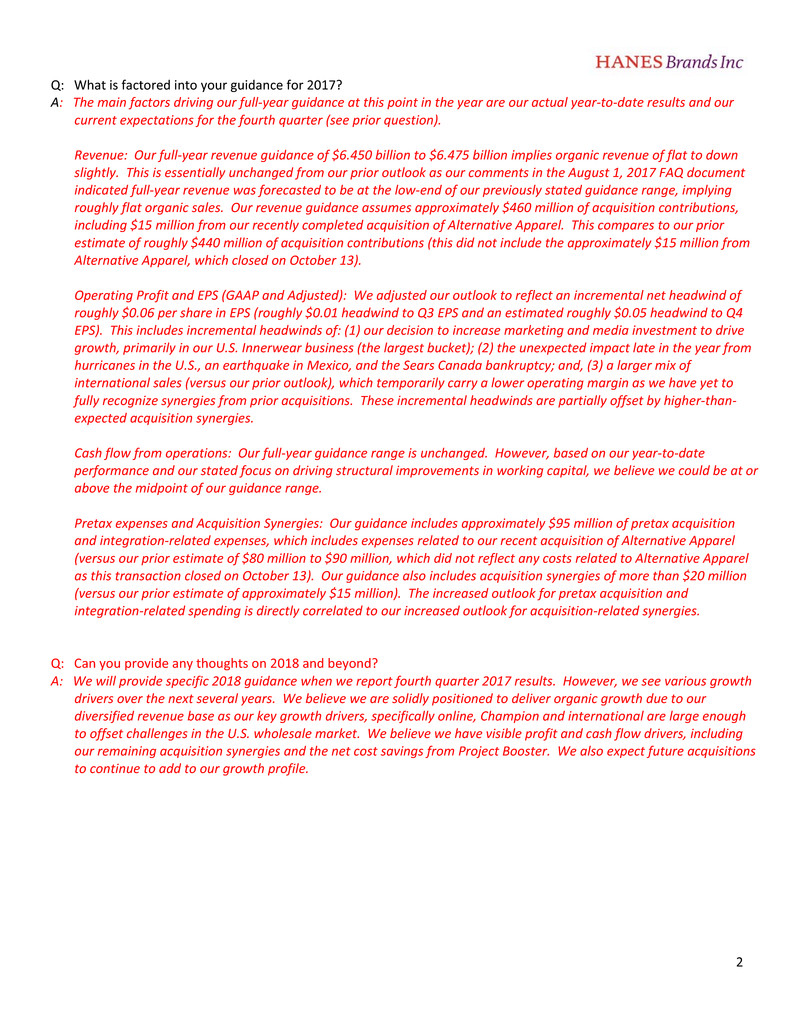
2 Q: What is factored into your guidance for 2017? A: The main factors driving our full‐year guidance at this point in the year are our actual year‐to‐date results and our current expectations for the fourth quarter (see prior question). Revenue: Our full‐year revenue guidance of $6.450 billion to $6.475 billion implies organic revenue of flat to down slightly. This is essentially unchanged from our prior outlook as our comments in the August 1, 2017 FAQ document indicated full‐year revenue was forecasted to be at the low‐end of our previously stated guidance range, implying roughly flat organic sales. Our revenue guidance assumes approximately $460 million of acquisition contributions, including $15 million from our recently completed acquisition of Alternative Apparel. This compares to our prior estimate of roughly $440 million of acquisition contributions (this did not include the approximately $15 million from Alternative Apparel, which closed on October 13). Operating Profit and EPS (GAAP and Adjusted): We adjusted our outlook to reflect an incremental net headwind of roughly $0.06 per share in EPS (roughly $0.01 headwind to Q3 EPS and an estimated roughly $0.05 headwind to Q4 EPS). This includes incremental headwinds of: (1) our decision to increase marketing and media investment to drive growth, primarily in our U.S. Innerwear business (the largest bucket); (2) the unexpected impact late in the year from hurricanes in the U.S., an earthquake in Mexico, and the Sears Canada bankruptcy; and, (3) a larger mix of international sales (versus our prior outlook), which temporarily carry a lower operating margin as we have yet to fully recognize synergies from prior acquisitions. These incremental headwinds are partially offset by higher‐than‐ expected acquisition synergies. Cash flow from operations: Our full‐year guidance range is unchanged. However, based on our year‐to‐date performance and our stated focus on driving structural improvements in working capital, we believe we could be at or above the midpoint of our guidance range. Pretax expenses and Acquisition Synergies: Our guidance includes approximately $95 million of pretax acquisition and integration‐related expenses, which includes expenses related to our recent acquisition of Alternative Apparel (versus our prior estimate of $80 million to $90 million, which did not reflect any costs related to Alternative Apparel as this transaction closed on October 13). Our guidance also includes acquisition synergies of more than $20 million (versus our prior estimate of approximately $15 million). The increased outlook for pretax acquisition and integration‐related spending is directly correlated to our increased outlook for acquisition‐related synergies. Q: Can you provide any thoughts on 2018 and beyond? A: We will provide specific 2018 guidance when we report fourth quarter 2017 results. However, we see various growth drivers over the next several years. We believe we are solidly positioned to deliver organic growth due to our diversified revenue base as our key growth drivers, specifically online, Champion and international are large enough to offset challenges in the U.S. wholesale market. We believe we have visible profit and cash flow drivers, including our remaining acquisition synergies and the net cost savings from Project Booster. We also expect future acquisitions to continue to add to our growth profile.
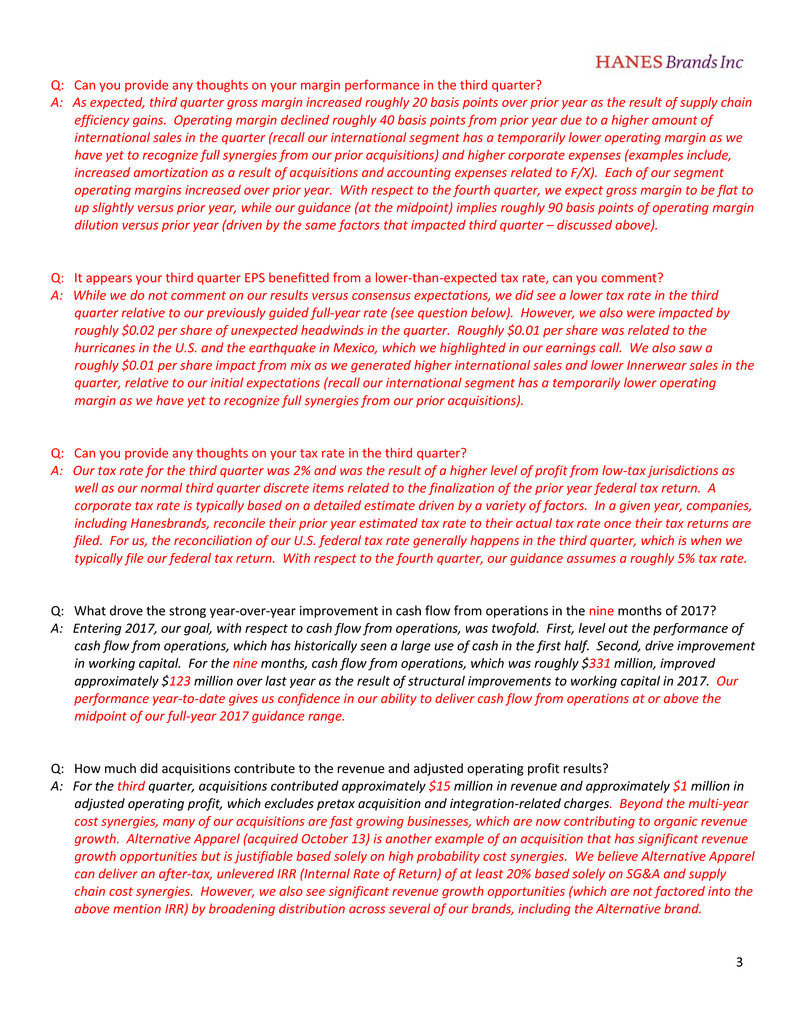
3 Q: Can you provide any thoughts on your margin performance in the third quarter? A: As expected, third quarter gross margin increased roughly 20 basis points over prior year as the result of supply chain efficiency gains. Operating margin declined roughly 40 basis points from prior year due to a higher amount of international sales in the quarter (recall our international segment has a temporarily lower operating margin as we have yet to recognize full synergies from our prior acquisitions) and higher corporate expenses (examples include, increased amortization as a result of acquisitions and accounting expenses related to F/X). Each of our segment operating margins increased over prior year. With respect to the fourth quarter, we expect gross margin to be flat to up slightly versus prior year, while our guidance (at the midpoint) implies roughly 90 basis points of operating margin dilution versus prior year (driven by the same factors that impacted third quarter – discussed above). Q: It appears your third quarter EPS benefitted from a lower‐than‐expected tax rate, can you comment? A: While we do not comment on our results versus consensus expectations, we did see a lower tax rate in the third quarter relative to our previously guided full‐year rate (see question below). However, we also were impacted by roughly $0.02 per share of unexpected headwinds in the quarter. Roughly $0.01 per share was related to the hurricanes in the U.S. and the earthquake in Mexico, which we highlighted in our earnings call. We also saw a roughly $0.01 per share impact from mix as we generated higher international sales and lower Innerwear sales in the quarter, relative to our initial expectations (recall our international segment has a temporarily lower operating margin as we have yet to recognize full synergies from our prior acquisitions). Q: Can you provide any thoughts on your tax rate in the third quarter? A: Our tax rate for the third quarter was 2% and was the result of a higher level of profit from low‐tax jurisdictions as well as our normal third quarter discrete items related to the finalization of the prior year federal tax return. A corporate tax rate is typically based on a detailed estimate driven by a variety of factors. In a given year, companies, including Hanesbrands, reconcile their prior year estimated tax rate to their actual tax rate once their tax returns are filed. For us, the reconciliation of our U.S. federal tax rate generally happens in the third quarter, which is when we typically file our federal tax return. With respect to the fourth quarter, our guidance assumes a roughly 5% tax rate. Q: What drove the strong year‐over‐year improvement in cash flow from operations in the nine months of 2017? A: Entering 2017, our goal, with respect to cash flow from operations, was twofold. First, level out the performance of cash flow from operations, which has historically seen a large use of cash in the first half. Second, drive improvement in working capital. For the nine months, cash flow from operations, which was roughly $331 million, improved approximately $123 million over last year as the result of structural improvements to working capital in 2017. Our performance year‐to‐date gives us confidence in our ability to deliver cash flow from operations at or above the midpoint of our full‐year 2017 guidance range. Q: How much did acquisitions contribute to the revenue and adjusted operating profit results? A: For the third quarter, acquisitions contributed approximately $15 million in revenue and approximately $1 million in adjusted operating profit, which excludes pretax acquisition and integration‐related charges. Beyond the multi‐year cost synergies, many of our acquisitions are fast growing businesses, which are now contributing to organic revenue growth. Alternative Apparel (acquired October 13) is another example of an acquisition that has significant revenue growth opportunities but is justifiable based solely on high probability cost synergies. We believe Alternative Apparel can deliver an after‐tax, unlevered IRR (Internal Rate of Return) of at least 20% based solely on SG&A and supply chain cost synergies. However, we also see significant revenue growth opportunities (which are not factored into the above mention IRR) by broadening distribution across several of our brands, including the Alternative brand.
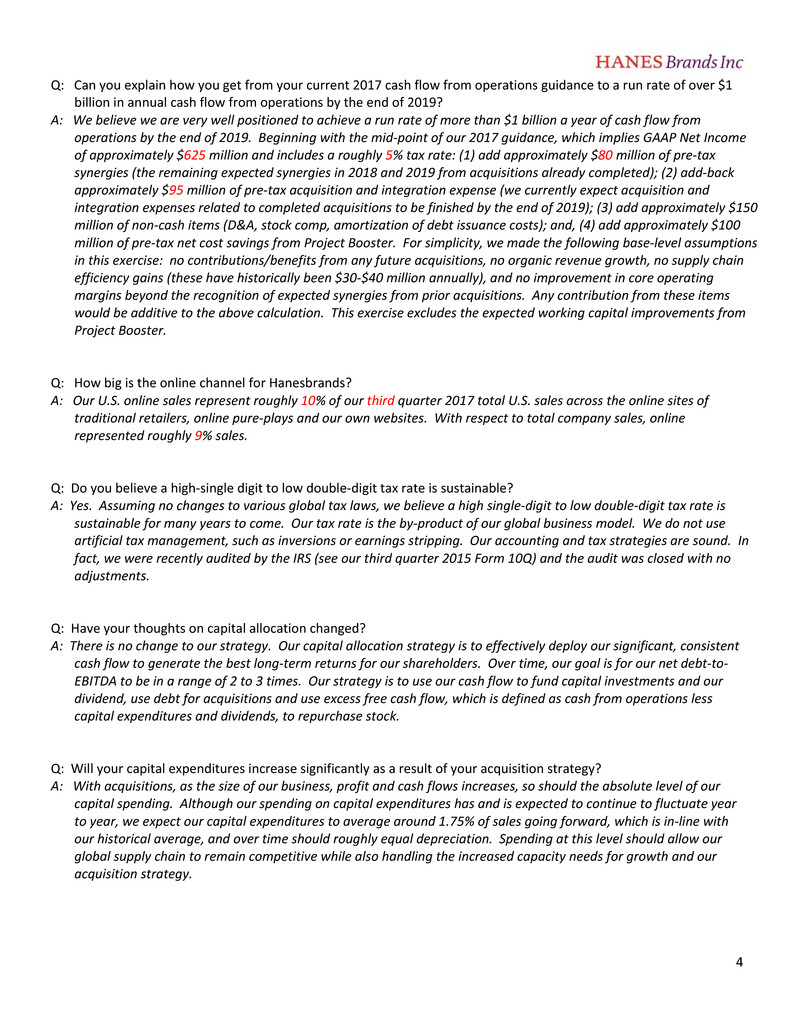
4 Q: Can you explain how you get from your current 2017 cash flow from operations guidance to a run rate of over $1 billion in annual cash flow from operations by the end of 2019? A: We believe we are very well positioned to achieve a run rate of more than $1 billion a year of cash flow from operations by the end of 2019. Beginning with the mid‐point of our 2017 guidance, which implies GAAP Net Income of approximately $625 million and includes a roughly 5% tax rate: (1) add approximately $80 million of pre‐tax synergies (the remaining expected synergies in 2018 and 2019 from acquisitions already completed); (2) add‐back approximately $95 million of pre‐tax acquisition and integration expense (we currently expect acquisition and integration expenses related to completed acquisitions to be finished by the end of 2019); (3) add approximately $150 million of non‐cash items (D&A, stock comp, amortization of debt issuance costs); and, (4) add approximately $100 million of pre‐tax net cost savings from Project Booster. For simplicity, we made the following base‐level assumptions in this exercise: no contributions/benefits from any future acquisitions, no organic revenue growth, no supply chain efficiency gains (these have historically been $30‐$40 million annually), and no improvement in core operating margins beyond the recognition of expected synergies from prior acquisitions. Any contribution from these items would be additive to the above calculation. This exercise excludes the expected working capital improvements from Project Booster. Q: How big is the online channel for Hanesbrands? A: Our U.S. online sales represent roughly 10% of our third quarter 2017 total U.S. sales across the online sites of traditional retailers, online pure‐plays and our own websites. With respect to total company sales, online represented roughly 9% sales. Q: Do you believe a high‐single digit to low double‐digit tax rate is sustainable? A: Yes. Assuming no changes to various global tax laws, we believe a high single‐digit to low double‐digit tax rate is sustainable for many years to come. Our tax rate is the by‐product of our global business model. We do not use artificial tax management, such as inversions or earnings stripping. Our accounting and tax strategies are sound. In fact, we were recently audited by the IRS (see our third quarter 2015 Form 10Q) and the audit was closed with no adjustments. Q: Have your thoughts on capital allocation changed? A: There is no change to our strategy. Our capital allocation strategy is to effectively deploy our significant, consistent cash flow to generate the best long‐term returns for our shareholders. Over time, our goal is for our net debt‐to‐ EBITDA to be in a range of 2 to 3 times. Our strategy is to use our cash flow to fund capital investments and our dividend, use debt for acquisitions and use excess free cash flow, which is defined as cash from operations less capital expenditures and dividends, to repurchase stock. Q: Will your capital expenditures increase significantly as a result of your acquisition strategy? A: With acquisitions, as the size of our business, profit and cash flows increases, so should the absolute level of our capital spending. Although our spending on capital expenditures has and is expected to continue to fluctuate year to year, we expect our capital expenditures to average around 1.75% of sales going forward, which is in‐line with our historical average, and over time should roughly equal depreciation. Spending at this level should allow our global supply chain to remain competitive while also handling the increased capacity needs for growth and our acquisition strategy.
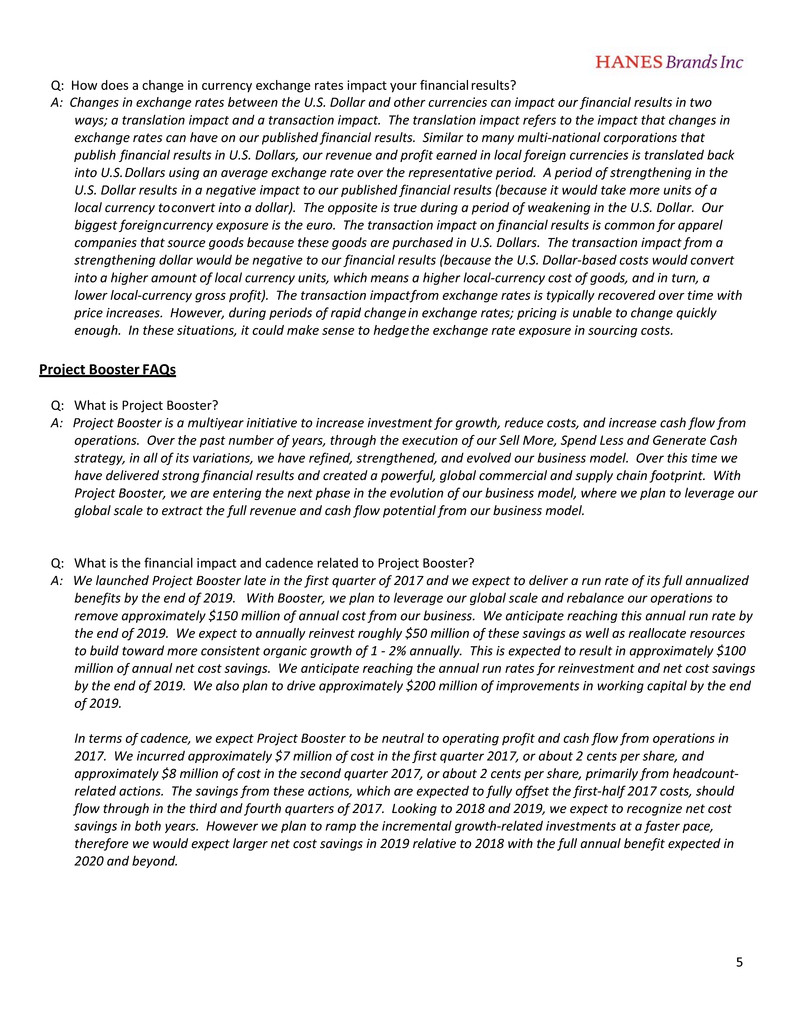
5 Q: How does a change in currency exchange rates impact your financial results? A: Changes in exchange rates between the U.S. Dollar and other currencies can impact our financial results in two ways; a translation impact and a transaction impact. The translation impact refers to the impact that changes in exchange rates can have on our published financial results. Similar to many multi‐national corporations that publish financial results in U.S. Dollars, our revenue and profit earned in local foreign currencies is translated back into U.S. Dollars using an average exchange rate over the representative period. A period of strengthening in the U.S. Dollar results in a negative impact to our published financial results (because it would take more units of a local currency to convert into a dollar). The opposite is true during a period of weakening in the U.S. Dollar. Our biggest foreign currency exposure is the euro. The transaction impact on financial results is common for apparel companies that source goods because these goods are purchased in U.S. Dollars. The transaction impact from a strengthening dollar would be negative to our financial results (because the U.S. Dollar‐based costs would convert into a higher amount of local currency units, which means a higher local‐currency cost of goods, and in turn, a lower local‐currency gross profit). The transaction impact from exchange rates is typically recovered over time with price increases. However, during periods of rapid change in exchange rates; pricing is unable to change quickly enough. In these situations, it could make sense to hedge the exchange rate exposure in sourcing costs. Project Booster FAQs Q: What is Project Booster? A: Project Booster is a multiyear initiative to increase investment for growth, reduce costs, and increase cash flow from operations. Over the past number of years, through the execution of our Sell More, Spend Less and Generate Cash strategy, in all of its variations, we have refined, strengthened, and evolved our business model. Over this time we have delivered strong financial results and created a powerful, global commercial and supply chain footprint. With Project Booster, we are entering the next phase in the evolution of our business model, where we plan to leverage our global scale to extract the full revenue and cash flow potential from our business model. Q: What is the financial impact and cadence related to Project Booster? A: We launched Project Booster late in the first quarter of 2017 and we expect to deliver a run rate of its full annualized benefits by the end of 2019. With Booster, we plan to leverage our global scale and rebalance our operations to remove approximately $150 million of annual cost from our business. We anticipate reaching this annual run rate by the end of 2019. We expect to annually reinvest roughly $50 million of these savings as well as reallocate resources to build toward more consistent organic growth of 1 ‐ 2% annually. This is expected to result in approximately $100 million of annual net cost savings. We anticipate reaching the annual run rates for reinvestment and net cost savings by the end of 2019. We also plan to drive approximately $200 million of improvements in working capital by the end of 2019. In terms of cadence, we expect Project Booster to be neutral to operating profit and cash flow from operations in 2017. We incurred approximately $7 million of cost in the first quarter 2017, or about 2 cents per share, and approximately $8 million of cost in the second quarter 2017, or about 2 cents per share, primarily from headcount‐ related actions. The savings from these actions, which are expected to fully offset the first‐half 2017 costs, should flow through in the third and fourth quarters of 2017. Looking to 2018 and 2019, we expect to recognize net cost savings in both years. However we plan to ramp the incremental growth‐related investments at a faster pace, therefore we would expect larger net cost savings in 2019 relative to 2018 with the full annual benefit expected in 2020 and beyond.

6 Q: Does Project Booster include benefits from prior strategies or prior acquisitions? A: No. The benefits from Project Booster are on top of our anticipated annual $30 ‐ $40 million of supply chain efficiency gains as well as on top of the expected remaining synergies from our prior acquisitions. Project Booster‐related costs, roughly $15 million in the first half of 2017 (see prior question), are reflected in our adjusted operating results, which means these costs are not part of our acquisition and integration‐related charges. Q: Does Project Booster signal an end to or a diminished focus on your acquisition strategy? A: No. Acquisitions remain a key component of our long‐term growth strategy as does our overall capital allocation strategy. Acquisitions have generated significant incremental returns for shareholders. Since 2013, acquisitions have brought with them approximately $2.4 billion in sales and approximately $200 million of operating profit, excluding acquisition and integration‐related expenses. Assuming full synergies, these acquisitions are expected to deliver roughly $420 million of operating profit, excluding acquisition and integration‐related charges, or more than double their original operating profit base. Through the end of the first quarter 2017, we have generated approximately $125 million of acquisition synergies with another roughly $95 million expected over the time period between the second quarter 2017 and the end of 2019. Project Booster is not about de‐emphasizing our current strategies, rather it is designed to further enhance them. Project Booster positions us to leverage the large, global footprint we created through acquisitions to reduce cost, to reinvest a portion of these savings to step‐up growth‐related investments, and to improve working capital to generate higher levels of sustainable cash flow from operations. We believe applying our balanced capital allocation strategy to these higher levels of cash flow positons us to continue to drive strong returns for shareholders. Q: Where do you plan to invest the roughly $50 million from Project Booster to drive more consistent organic growth? A: The changing retail environment requires a shift of our resources as well as the need for a step‐up in investment. Through Project Booster, we plan to build toward more consistent organic growth of 1 ‐ 2% annually by reallocating resources as well as increasing our annual investment in growth‐related initiatives, reaching a run rate of approximately $50 million by the end of 2019. These investments are being funded with a portion of the expected annual savings from Booster. Areas of investment include: (1) increased investment in our global portfolio of leading brands, including brand building and marketing support; (2) accelerated development of our global omnichannel capabilities, including online in the U.S. as well as online and retail in our international markets; and, (3) further expansion of our Champion brand globally, driving to $2 billion in global sales (versus more than $1.2 billion at the end of 2016). Q: How do you plan to generate a run rate of roughly $150 million of annual cost savings from Project Booster by the end of 2019? A: Our cost reduction efforts, which are expected to build to a run rate of roughly $150 million of annual cost savings by the end of 2019, are being driven by two initiatives. The first, and most significant, initiative is to further lower cost within our supply chain by leveraging our increased global scale. Note, the Booster‐related cost savings come on top of the expected synergies from prior acquisitions as well as on top of our expected annual supply chain efficiency gains (see question at top of page). Examples include: procurement and product development efficiencies, utilizing global fabric platforms and silhouettes, the redesign of our distribution network to more efficiently ship online orders, and further optimizing our global textile and sewing operations to improve product flows. The second cost reduction initiative is to reduce organizational overhead, including headcount, to better match resources with opportunities as well as to reflect trends on a market‐by‐market basis. Q: How do you plan to generate roughly $200 million of incremental cash flow through working capital improvements related to Project Booster? A: The expected roughly $200 million of working capital improvements, include improvements in inventory turns, accounts receivable, and accounts payable.
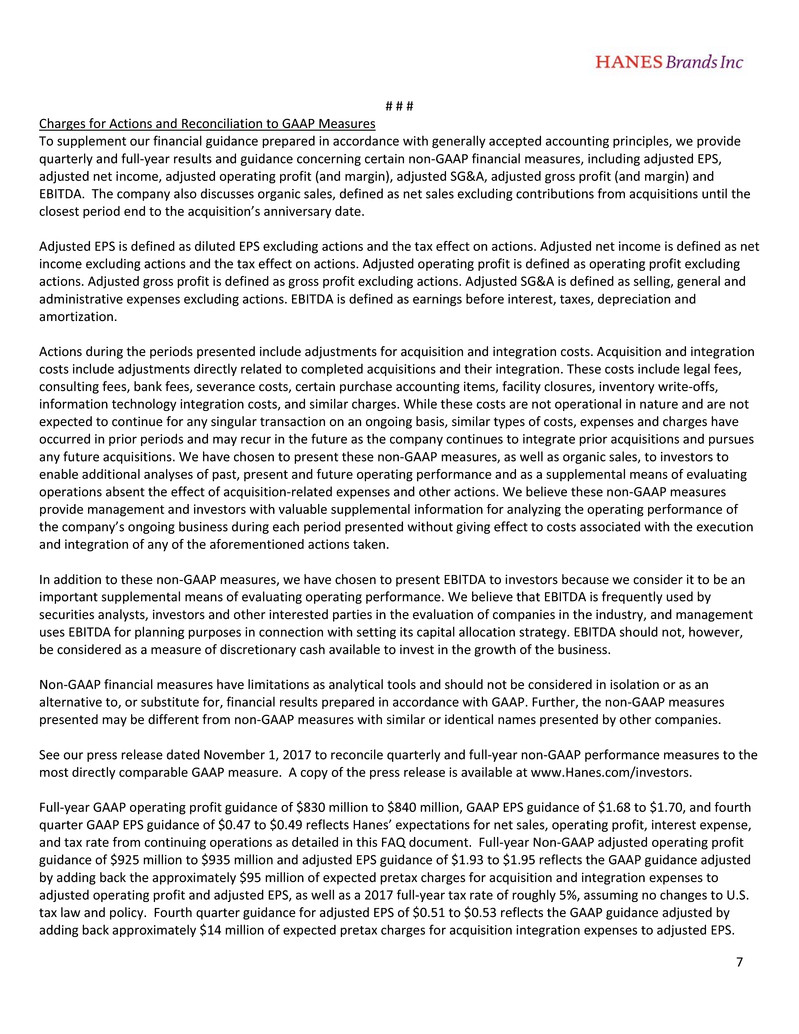
7 # # # Charges for Actions and Reconciliation to GAAP Measures To supplement our financial guidance prepared in accordance with generally accepted accounting principles, we provide quarterly and full‐year results and guidance concerning certain non‐GAAP financial measures, including adjusted EPS, adjusted net income, adjusted operating profit (and margin), adjusted SG&A, adjusted gross profit (and margin) and EBITDA. The company also discusses organic sales, defined as net sales excluding contributions from acquisitions until the closest period end to the acquisition’s anniversary date. Adjusted EPS is defined as diluted EPS excluding actions and the tax effect on actions. Adjusted net income is defined as net income excluding actions and the tax effect on actions. Adjusted operating profit is defined as operating profit excluding actions. Adjusted gross profit is defined as gross profit excluding actions. Adjusted SG&A is defined as selling, general and administrative expenses excluding actions. EBITDA is defined as earnings before interest, taxes, depreciation and amortization. Actions during the periods presented include adjustments for acquisition and integration costs. Acquisition and integration costs include adjustments directly related to completed acquisitions and their integration. These costs include legal fees, consulting fees, bank fees, severance costs, certain purchase accounting items, facility closures, inventory write‐offs, information technology integration costs, and similar charges. While these costs are not operational��in nature and are not expected to continue for any singular transaction on an ongoing basis, similar types of costs, expenses and charges have occurred in prior periods and may recur in the future as the company continues to integrate prior acquisitions and pursues any future acquisitions. We have chosen to present these non‐GAAP measures, as well as organic sales, to investors to enable additional analyses of past, present and future operating performance and as a supplemental means of evaluating operations absent the effect of acquisition‐related expenses and other actions. We believe these non‐GAAP measures provide management and investors with valuable supplemental information for analyzing the operating performance of the company’s ongoing business during each period presented without giving effect to costs associated with the execution and integration of any of the aforementioned actions taken. In addition to these non‐GAAP measures, we have chosen to present EBITDA to investors because we consider it to be an important supplemental means of evaluating operating performance. We believe that EBITDA is frequently used by securities analysts, investors and other interested parties in the evaluation of companies in the industry, and management uses EBITDA for planning purposes in connection with setting its capital allocation strategy. EBITDA should not, however, be considered as a measure of discretionary cash available to invest in the growth of the business. Non‐GAAP financial measures have limitations as analytical tools and should not be considered in isolation or as an alternative to, or substitute for, financial results prepared in accordance with GAAP. Further, the non‐GAAP measures presented may be different from non‐GAAP measures with similar or identical names presented by other companies. See our press release dated November 1, 2017 to reconcile quarterly and full‐year non‐GAAP performance measures to the most directly comparable GAAP measure. A copy of the press release is available at www.Hanes.com/investors. Full‐year GAAP operating profit guidance of $830 million to $840 million, GAAP EPS guidance of $1.68 to $1.70, and fourth quarter GAAP EPS guidance of $0.47 to $0.49 reflects Hanes’ expectations for net sales, operating profit, interest expense, and tax rate from continuing operations as detailed in this FAQ document. Full‐year Non‐GAAP adjusted operating profit guidance of $925 million to $935 million and adjusted EPS guidance of $1.93 to $1.95 reflects the GAAP guidance adjusted by adding back the approximately $95 million of expected pretax charges for acquisition and integration expenses to adjusted operating profit and adjusted EPS, as well as a 2017 full‐year tax rate of roughly 5%, assuming no changes to U.S. tax law and policy. Fourth quarter guidance for adjusted EPS of $0.51 to $0.53 reflects the GAAP guidance adjusted by adding back approximately $14 million of expected pretax charges for acquisition integration expenses to adjusted EPS.
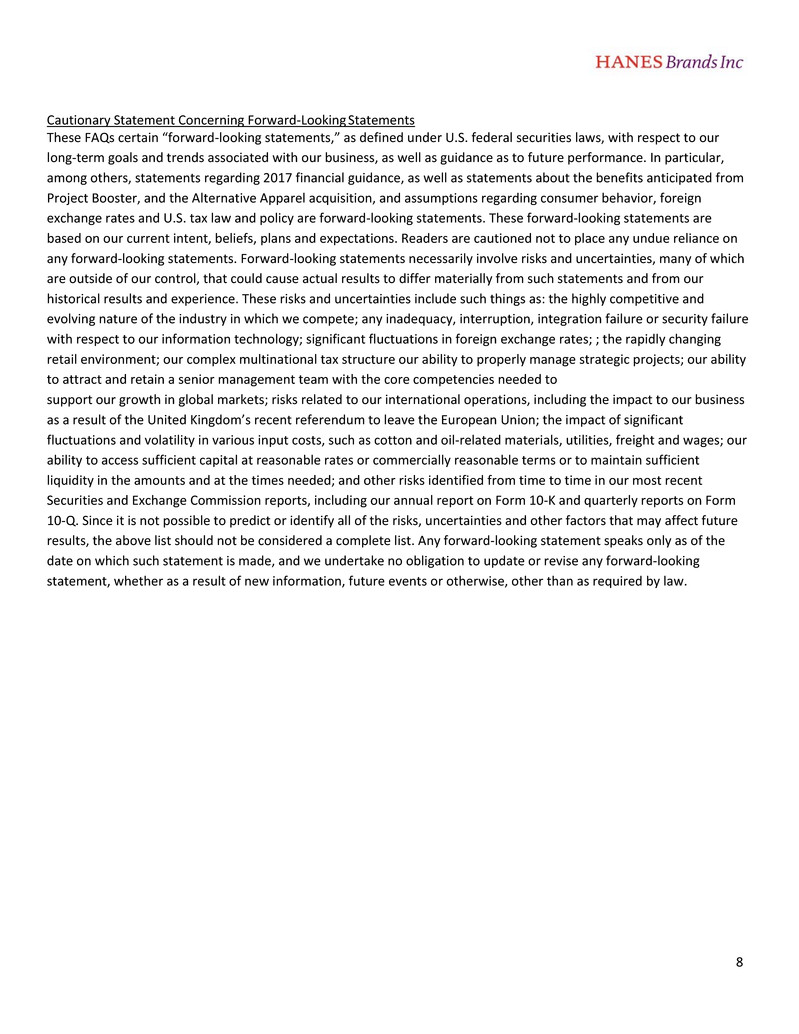
8 Cautionary Statement Concerning Forward‐Looking Statements These FAQs certain “forward‐looking statements,” as defined under U.S. federal securities laws, with respect to our long‐term goals and trends associated with our business, as well as guidance as to future performance. In particular, among others, statements regarding 2017 financial guidance, as well as statements about the benefits anticipated from Project Booster, and the Alternative Apparel acquisition, and assumptions regarding consumer behavior, foreign exchange rates and U.S. tax law and policy are forward‐looking statements. These forward‐looking statements are based on our current intent, beliefs, plans and expectations. Readers are cautioned not to place any undue reliance on any forward‐looking statements. Forward‐looking statements necessarily involve risks and uncertainties, many of which are outside of our control, that could cause actual results to differ materially from such statements and from our historical results and experience. These risks and uncertainties include such things as: the highly competitive and evolving nature of the industry in which we compete; any inadequacy, interruption, integration failure or security failure with respect to our information technology; significant fluctuations in foreign exchange rates; ; the rapidly changing retail environment; our complex multinational tax structure our ability to properly manage strategic projects; our ability to attract and retain a senior management team with the core competencies needed to support our growth in global markets; risks related to our international operations, including the impact to our business as a result of the United Kingdom’s recent referendum to leave the European Union; the impact of significant fluctuations and volatility in various input costs, such as cotton and oil‐related materials, utilities, freight and wages; our ability to access sufficient capital at reasonable rates or commercially reasonable terms or to maintain sufficient liquidity in the amounts and at the times needed; and other risks identified from time to time in our most recent Securities and Exchange Commission reports, including our annual report on Form 10‐K and quarterly reports on Form 10‐Q. Since it is not possible to predict or identify all of the risks, uncertainties and other factors that may affect future results, the above list should not be considered a complete list. Any forward‐looking statement speaks only as of the date on which such statement is made, and we undertake no obligation to update or revise any forward‐looking statement, whether as a result of new information, future events or otherwise, other than as required by law.







